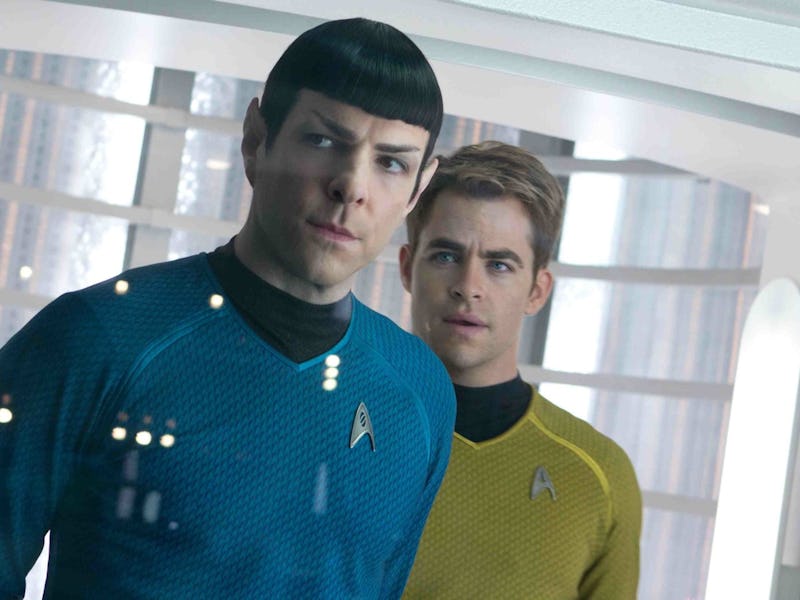The Most Thrilling, Frustrating Star Trek Movie Ever Still Has Moments of Brilliance
If you want to understand who J.J. Abrams is as a filmmaker, then look no further than this 2013 blockbuster.

Few contemporary filmmakers have made as much of a mark on the entertainment industry as J.J. Abrams. After emerging in the late ‘90s as one of the most prolific TV creators of his generation, Abrams spent the majority of the 2000s and 2010s becoming a major creative voice behind some of Hollywood’s biggest franchises. Looking back on them now, it seems safe to say that most of Abrams’ franchise efforts ultimately ended in disaster. However, as regrettable as, say, Star Wars: Episode IX — The Rise of Skywalker may have been, even Abrams’ worst films contain moments of brilliance.
That’s particularly true of Star Trek Into Darkness. The film, Abrams’ sequel to his massively success Star Trek reboot from 2009, is simultaneously one of the most thrilling movies that its director has ever made and also one of his most frustrating. Across its runtime, the film manages to highlight all of Abrams’ greatest strengths and weaknesses, which combine to create a sci-fi thriller that is always entertaining and yet dramatically empty.
The divisive blockbuster is leaving Netflix at the end of this month, and it is well worth seeking out — if only to rediscover all the things about it that both lift it up and hold it back.
Set a number of years after its 2009 predecessor, Star Trek Into Darkness follows Chris Pine’s Captain James T. Kirk and the crew of the USS Enterprise as they find themselves unexpectedly caught in a deadly conflict involving a mysterious galactic terrorist known only as John Harrison (Benedict Cumberbatch). When Harrison’s efforts result in the tragic death of Kirk’s mentor, Christopher Pike (Bruce Greenwood), Kirk sets out to capture the fugitive and bring him to justice. The Enterprise captain’s mission is upended, however, when the true nature of Harrison’s relationship with Starfleet Admiral Alexander Marcus (Peter Weller) is revealed.
From there, Star Trek Into Darkness quickly and not-so-shockingly devolves into what is essentially a remix of its franchise’s most beloved and acclaimed big-screen adventure, 1982’s Star Trek II: The Wrath of Khan. Indeed, not only does Into Darkness introduce a less interesting version of that film’s iconic villain, but it also recycles some of its predecessor’s biggest dramatic beats. In doing so, Into Darkness invites inevitable comparisons between it and The Wrath of Khan, which remains a far superior film, as well as reveals itself to be devoid of any of its own ideas.
Much like both of J.J. Abrams’ Star Wars films, Into Darkness relies too heavily on replaying its franchise’s greatest hits. It’s a sequel that frustratingly refuses to deviate from the path already set by films that were made decades before it. The movie, in other words, succumbs to the same pull of nostalgia that has haunted much of its director’s career. Despite that fact, it’s also one of the most propulsive and engaging movies that Abrams has ever made.
Star Trek Into Darkness is a visually astonishing sci-fi blockbuster that tells a disappointingly familiar story.
In many ways, Star Trek Into Darkness finds J.J. Abrams working at the height of his visual and formal powers. Whether it be the film’s opening set piece, which takes place on a planet covered in visually striking red foliage, or the double-reversal fight that sees Cumberbatch’s villain violently take control of a massive Starfleet warship, Into Darkness is full of sequences that are viscerally effective and visually dynamic. In general, there’s a confident energy pulsing beneath Into Darkness that imbues even its most narratively tired and familiar moments with a vigor that’s hard to deny.
After taking a break from the franchise to make 2011’s Super 8, Abrams returned to Star Trek with a more-is-everything approach (more cross-cutting, more lens flares, more explosions, more Dutch angles!). The result is a maximalist, in-your-face sci-fi blockbuster that serves as strong proof of Abrams’ skills as a visual craftsman. Combine that with the film’s disappointingly familiar, nostalgia-bait plot, and what you’ve got is a well-made sci-fi blockbuster that can easily be enjoyed — so long as you turn your brain off.
If anything, Star Trek Into Darkness is proof that Abrams is probably better off making movies that are not only written by someone else but also exist outside of the franchise space altogether.